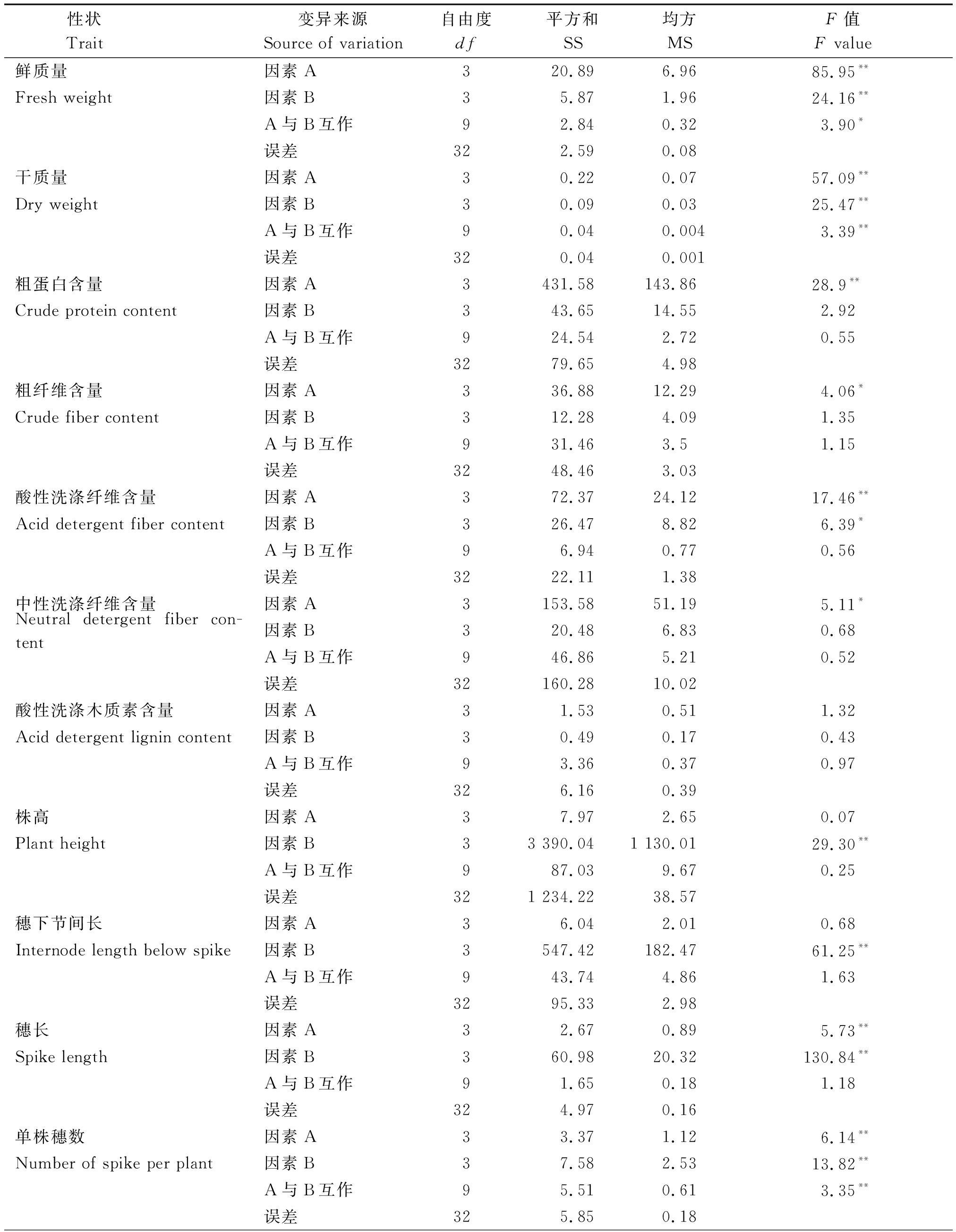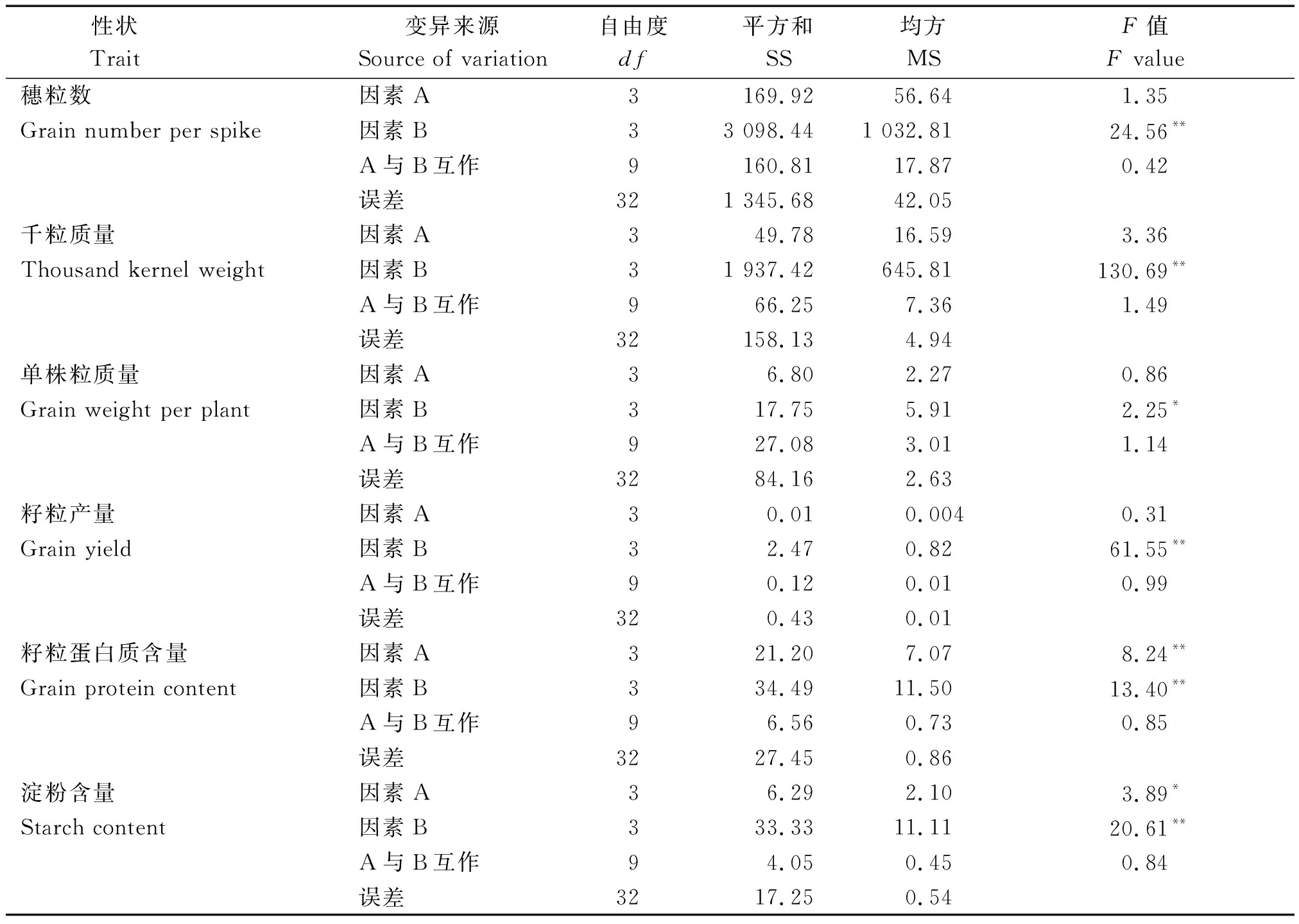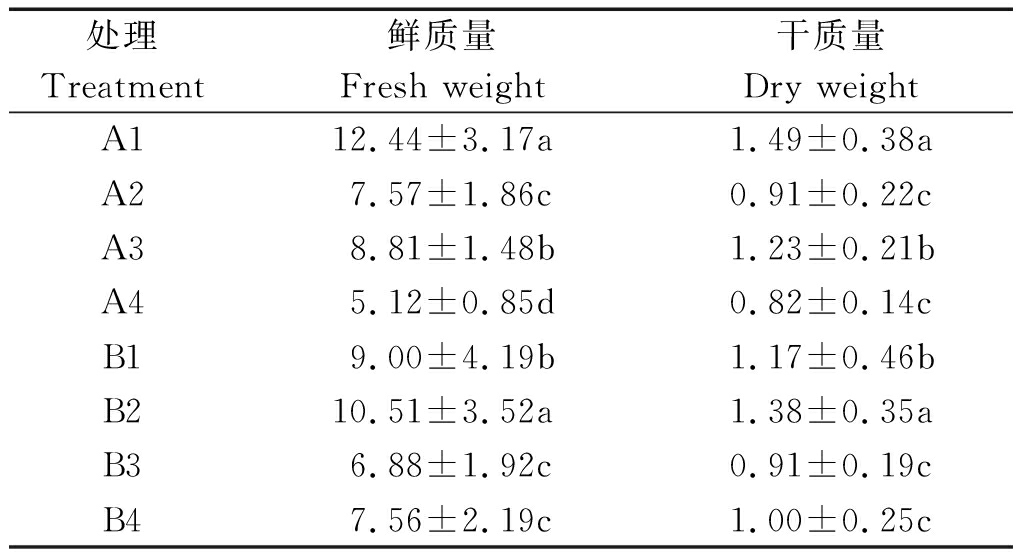大麦(Hordeum vulagre L.)是优质饲料作物,除籽粒饲用外,可以利用其绿色植株生产青饲或青贮饲料,饲用品质好[1],利用方式灵活[2],正在世界范围内获得广泛应用[3-6]。大麦饲草产量与品质受刈割期[7-8]、刈割次数[9-10]、播种密度[6]及种植方式[5,11]等影响,在品种间也存在差异[12-14]。一些研究表明,分蘖期收获大麦饲草对后期生长影响不大,成熟期仍可收获籽粒[6,15],能实现饲草与籽粒兼收,但不同生态区差别大,生产技术难以统一。
本试验前期研究亦表明,我国冬麦区分蘖期刈割大麦虽能实现饲草与籽粒兼收,但适期播种下,越冬前大麦生长量有限,饲草产量难以提升[7,12]。然而,早播对大麦饲草及籽粒产量和品质的影响及品种间是否存在差异等,尚不清楚。为此,本研究以冬麦区4个多棱饲料大麦新品种为材料,设置4个播期,探讨播期对不同品种大麦饲草及籽粒产量和品质的影响,为更好地实现饲草与籽粒兼收提供技术支撑。
1 材料和方法
1.1 试验地概况
试验地位于安徽省农业科学院试验基地,北纬31°89′,东经117°25′,海拔19.8 m,四季分明,光照充足,雨量适中。大麦于10月下旬播种,次年5月中旬收获,生育期平均降水量411.6 mm,日平均气温11.2 ℃。试验地为壤土,前茬大豆,土壤pH值6.1,硝态氮、有效磷、速效钾含量分别是34.7,38.9,144.4 mg/kg。
1.2 试验材料
参试的4个多棱饲料大麦是冬麦区具代表性的大麦新品种,均具分蘖强、再生性好与抗倒伏等特点,适宜全株饲用。品种名称及来源地见表1,其中皖饲啤14008为自育大麦新品种。
1.3 试验设计
试验于2018-2019年实施,设播期(因素A)和品种(因素B)2个因素(表1)。刈割于分蘖期进行,刈割标准为大麦主茎叶长25 cm,留茬高度为2 cm,每次刈割后追施纯氮35 kg/hm2,拔节期停止刈割,成熟期收获籽粒。按每亩20万基本苗播种,田间采用随机区组设计,3次重复,小区面积2.5 m2,每小区5行,行长2.00 m,行距0.25 m,田间正常管理。
表1 参试大麦播期、品种名称、来源地及处理编号
Tab.1 Sowing dates,names,origins of barley varieties and treatment codes in this experiment

因素AFactor A播期(年-月-日)Sowing date因素BFactor B品种Variety来源地Origin处理TreatmentA12018-09-30B1扬饲麦1号 江苏 A1B1、A1B2、A1B3、A1B4A22018-10-10B2皖饲啤14008 安徽 A2B1、A2B2、A2B3、A2B4A32018-10-20B3保大麦14号 云南 A3B1、A3B2、A3B3、A3B4A42018-10-30B4川农饲麦5号 四川A4B1、A4B2、A4B3、A4B4
1.4 测定项目与方法
达刈割标准时,刈割小区测定大麦饲草鲜质量,再取样300 g于70 ℃烘箱烘干48 h,测定干鲜比,计算干质量。烘干样品磨粉后用于大麦饲草品质检测,指标包括粗蛋白、粗纤维、酸性洗涤纤维、中性洗涤纤维及酸性洗涤木质素,测定方法参见相关标准执行[16]。成熟后,每小区取10株考种,测定的籽粒产量指标包括株高、穗下节间长、穗长、单株穗数、穗粒数、千粒质量、单株粒质量及小区产量。籽粒蛋白质与淀粉含量使用Infratec TM 1241近红外谷物分析仪进行测定。
1.5 统计分析
试验数据处理分析采用SAS 8.1软件,按两因素互作模型对数据结果进行方差分析与多重比较。
2 结果与分析
2.1 大麦的刈割次数
播后材料达刈割标准时开始刈割,再生植株达刈割标准时进行重复刈割,进入拔节期停止刈割。播期为A1时,大麦可刈割3次;播期为A2与A3时,可刈割2次;播期为A4时,仅刈割1次。以A4适播期为对照,可见早播可以实现多次刈割。
2.2 大麦饲草产量的差异
播期、品种及两者间互作效应对大麦饲草鲜质量和干质量都产生影响,其中播期效应最大,品种效应其次,两者间互作效应较小(表2)。播期间大麦饲草鲜质量及干质量差异显著,由高到低依次为A1、A3、A2、A4,其中播期A1收获大麦饲草鲜质量(12.44 t/hm2)与干质量(1.49 t/hm2)最高,显著高于其他播期。品种间比较表明,品种B2鲜质量(10.51 t/hm2)和干质量(1.38 t/hm2)最高,显著高于其他品种;品种B1鲜质量(9.00 t/hm2)和干质量(1.17 t/hm2)其次,显著高于B3和B4,而B3与B4间差异不显著(表3)。
表2 大麦饲草及籽粒产量和品质的方差分析
Tab.2 Variance analysis of yield and quality of barley forage and grain

性状 Trait 变异来源Source of variation自由度df平方和SS均方MSF值 F value鲜质量因素A320.896.9685.95**Fresh weight因素B35.871.9624.16**A与B互作92.840.323.90*误差322.590.08干质量 因素A30.220.0757.09**Dry weight因素B30.090.0325.47**A与B互作90.040.0043.39**误差320.040.001粗蛋白含量 因素A 3431.58143.8628.9**Crude protein content因素B343.6514.552.92A与B互作924.542.720.55误差3279.654.98粗纤维含量 因素A336.8812.294.06*Crude fiber content因素B312.284.091.35A与B互作931.463.51.15误差3248.463.03酸性洗涤纤维含量 因素A372.3724.1217.46**Acid detergent fiber content因素B326.478.826.39*A与B互作96.940.770.56误差3222.111.38中性洗涤纤维含量因素A3153.5851.195.11*Neutral detergent fiber con-tent因素B320.486.830.68A与B互作946.865.210.52误差32160.2810.02酸性洗涤木质素含量因素A31.530.511.32Acid detergent lignin content因素B30.490.170.43A与B互作93.360.370.97误差326.160.39株高因素A37.972.650.07Plant height因素B33 390.041 130.0129.30**A与B互作987.039.670.25误差321 234.2238.57穗下节间长 因素A36.042.010.68Internode length below spike因素B3547.42182.4761.25**A与B互作943.744.861.63误差3295.332.98穗长因素A32.670.895.73**Spike length因素B360.9820.32130.84**A与B互作91.650.181.18误差324.970.16单株穗数 因素A33.371.126.14**Number of spike per plant因素B37.582.5313.82**A与B互作95.510.613.35**误差325.850.18
表2(续)

性状 Trait 变异来源Source of variation自由度df平方和SS均方MSF值 F value穗粒数因素A3169.9256.641.35Grain number per spike因素B33 098.441 032.8124.56**A与B互作9160.8117.870.42误差321 345.6842.05千粒质量 因素A349.7816.593.36Thousand kernel weight因素B31 937.42645.81130.69**A与B互作966.257.361.49误差32158.134.94单株粒质量因素A36.80 2.270.86Grain weight per plant因素B317.755.912.25*A与B互作927.083.011.14误差3284.162.63籽粒产量因素A30.010.0040.31Grain yield因素B32.470.8261.55**A与B互作90.120.010.99误差320.430.01籽粒蛋白质含量 因素A321.20 7.078.24**Grain protein content因素B 334.4911.50 13.40**A与B互作96.560.730.85误差3227.450.86淀粉含量因素A36.292.10 3.89*Starch content因素B333.3311.1120.61**A与B互作94.050.450.84误差3217.250.54
注:*和**分别表示在P<0.05和P<0.01水平上差异显著。
Note:* and**depict significant differences at 0.05 and 0.01 level,respectively.
表3 不同播期间与品种间大麦饲草鲜质量与干质量的差异
Tab.3 Comparison of differences in fresh
weight and dry weight of barley forage among
different sowing dates and varieties t/hm2

处理Treatment鲜质量Fresh weight干质量Dry weightA112.44±3.17a1.49±0.38aA27.57±1.86c0.91±0.22cA38.81±1.48b1.23±0.21bA45.12±0.85d0.82±0.14cB19.00±4.19b1.17±0.46bB210.51±3.52a1.38±0.35aB36.88±1.92c0.91±0.19cB47.56±2.19c1.00±0.25c
注:同列数据后不同小写字母表示在P<0.05水平上差异显著。表4-6同。
Note:Different lowercase letters following data within the same column show significant difference at 0.05 level. The same as Tab.4-6.
2.3 大麦饲草品质的差异
以各处理头茬大麦饲草为检测对象,比较播期和品种对饲草品质的影响。结果表明,播期效应较大,品种效应较小,两者间互作效应未对饲草品质产生影响(表2)。播期间,粗蛋白含量A2(304.5 g/kg)与A4(323.6 g/kg)显著高于A1(242.5 g/kg)与A3(241.3 g/kg);粗纤维含量A2(157.9 g/kg)与A4(151.6 g/kg)显著高于A1(130.5 g/kg)与A3(130.1 g/kg);酸性洗涤纤维含量A4(215.3 g/kg)显著高于其他播期,其次A2(196.1 g/kg)显著高于A1(182.6 g/kg)与A3(175.9 g/kg);中性洗涤纤维含量A4(407.8 g/kg)最高,与A1、A3差异显著;酸性洗涤木质素含量无显著差异。品种间,仅酸性洗涤纤维含量B1(178.3 g/kg)显著低于其他品种,其他性状则无显著差异(表4)。
2.4 大麦籽粒产量的差异
大麦籽粒产量及其相关性状受品种影响较大,播期影响较小,品种与播期间互作效应仅对单株穗数产生影响,对其他性状无影响(表2)。品种间,籽粒产量及其相关性状存在显著差异,其中品种B1产量最高(3.58 t/hm2),显著高于其他品种,品种B2产量其次(1.82 t/hm2),显著高于B3和B4,而B3与B4无显著差异。播期间,穗长、单株穗数和千粒质量存在一定差异,其他性状则无显著差异(表5)。
表4 不同播期间与品种间大麦饲草品质性状的差异
Tab.4 Comparison of differences in barley forage quality among different sowing dates and varieties g/kg

处理Treatment粗蛋白含量 Crude protein content粗纤维含量 Crude fiber content 酸性洗涤纤维含量Acid detergentfiber content 中性洗涤纤维含量Neutral detergentfiber content酸性洗涤木质素含量Acid detergentlignin content A1242.5±30.1b130.5±16.9b182.6±16.2c359.1±25.7b24.3±7.9aA2304.5±17.2a157.9±8.2a196.1±16.0b387.1±41.8ab19.5±5.3aA3241.3±20.6b130.1±10.9b175.9±11.0c353.5±16.8b23.5±5.3aA4323.6±22.1a151.6±29.1a215.3±12.4a407.8±23.7a25.3±4.9aB1288.0±39.2a142.3±20.3a178.3±17.3b369.8±37.4a23.3±7.6aB2271.9±53.3a136.3±26.2a191.0±17.7a369.9±38.2a23.3±3.5aB3268.8±37.8a152.9±10.2a199.0±21.2a389.3±33.3a21.3±8.2aB4273.3±43.0a147.8±21.6a201.6±19.6a378.6±34.5a24.8±4.5a
表5 不同播期间与品种间大麦籽粒产量及产量相关性状的差异
Tab.5 Comparison of differences in grain yield and its related traits among different sowing dates and varieties

处理Treatment株高/cmPlant height穗下节间长/cmInternode lengthbelow spike穗长/cmSpike length单株穗数Number ofspike per plant穗粒数Grain numberper spike千粒质量/gThousand kernelweight 单株粒质量/gGrain weightper plant产量/(t/hm2)Yield A170.26±10.66a28.18±4.80a4.73±1.09b3.96±1.04a44.36±8.90a38.65±7.29b6.57±1.81a2.03±1.05aA270.53±11.63a27.51±3.78a4.55±1.15b3.36±0.58b44.36±12.75a40.06±6.06ab5.94±2.27a1.97±1.05aA369.46±10.66a28.02±3.86a4.78±1.18b3.33±0.49b44.84±9.21a40.20±7.42ab5.83±1.03a2.15±1.13aA470.33±8.10a28.49±3.19a5.20±1.50a3.35±0.26b48.84±9.59a41.53±7.19a6.69±1.49a2.01±0.94aB183.04±4.29a33.60±1.79a4.11±0.28b4.08±0.90a55.56±5.61a31.12±1.89d7.08±1.93a3.58±0.50aB259.60±6.88c26.84±2.58b4.27±0.48b2.97±0.33c46.59±8.53b44.43±3.31b6.30±2.03ab1.82±0.51bB367.92±5.25b24.48±0.74c6.76±0.62a3.57±0.56b47.13±4.31b37.40±2.18c6.30±1.73ab1.44±0.35cB470.01±5.25b27.30±1.67b4.11±0.40b3.39±0.34b33.12±5.44c47.50±2.37a5.36±1.23b1.33±0.43c
2.5 大麦籽粒品质的差异
播期和品种影响大麦籽粒蛋白质和淀粉含量变化,其中品种效应较大,播期效应较小,而两者间互作效应未对其产生影响(表2)。品种间,B2蛋白含量最高(125.2 g/kg),显著高于其他品种,其次是B4(113.8 g/kg),显著高于B1和B3,而B1和B3间无显著差异;淀粉含量B1最高(556.8 g/kg),显著高于其他品种,其次是B3(543.8 g/kg),显著高于B2和B4,而B2和B4间无显著差异。播期间,A1蛋白质含量显著低于A2、A3和A4,淀粉含量则显著高于A3和A4,其他播期间蛋白质和淀粉含量无显著差异(表6)。
表6 不同播期间与品种间大麦籽粒品质性状的差异
Tab.6 Comparison of differences in grain quality traits
among different sowing dates and varieties g/kg

处理Treatment蛋白含量Protein content淀粉含量Starch contentA1101.3±13.1b548.8±12.6aA2114.3±12.8a544.6±11.9abA3113.5±11.9a541.2±10.7bA4119.3±12.0a539.3±9.1bB1105.9±11.8c556.8±8.9aB2125.2±12.4a534.6±7.1cB3103.4±11.3c543.8±8.6bB4113.8±9.1b538.8±6.7c
3 讨论与结论
3.1 播期与品种对大麦饲草及籽粒产量的影响
播期与品种影响作物饲草产量[17-19]。本研究播期对大麦饲草产量影响较大,但对籽粒产量影响较小。早播可增加刈割次数,收获更多饲草,如播期A1(9月30日)饲草产量最高,且不影响籽粒产量。品种间饲草及籽粒产量差异均显著,表明可以通过选择品种来提高饲草及籽粒产量。本研究品种B2(皖饲啤14008)饲草产量最高,籽粒产量居第2位,B1(扬饲麦1号)籽粒产量最高,饲草产量居第2位,两者均可作为饲草及籽粒兼用型品种,其中B2是自育的粮草双高型大麦新品种[20]。本研究播期与品种间互作对饲草产量有一定影响,但对籽粒产量无影响。因此,选择优良品种,提早播期,能实现饲草与籽粒兼收。
3.2 播期与品种对大麦饲草及籽粒品质的影响
本研究播期对大麦饲草品质影响较大,对籽粒品质影响较小。播期间饲草品质除酸性洗涤木质素含量外,其他性状存在显著差异,其中播期A2和A4相应性状值较高,可能与环境因素有关,有待进一步研究。品种间饲草品质基本无差异,但籽粒品质差异明显。与其他研究结果不同[21],本研究分蘖期各品种饲草品质相当,此阶段大麦茎叶柔嫩,营养丰富,所有品种粗蛋白含量都达25%以上,均可用作优质饲草。品种间籽粒品质差异明显,品种B2(皖饲啤14008)籽粒蛋白质含量最高,B1(扬饲麦1号)籽粒淀粉含量最高,表明可以结合需求选择品种,改善饲料品质。本研究播期与品种间互作未对饲草及籽粒品质产生影响。因此,选择品种,适当早播,可以兼顾饲草及籽粒品质。
基于本研究,综合饲草及籽粒产量和品质分析,冬麦区选用皖饲啤14008或扬饲麦1号,于9月30日播种,能达到优质饲草与籽粒兼收目标。
[1] 王勇生,王博,雷恒. 大麦的营养价值与提高其畜禽利用率的措施[J].中国饲料,2014(4):18-22. doi:10.15906/j.cnki.cn11-2975/s.2014.04.002.
Wang Y S,Wang B,Lei H. Nutritional values and measures for improving utilization ratio of barley[J].China Feed,2014(4):18-22.
[2] 季昌好,王瑞,陈晓东,赵斌,朱斌. 大麦绿植体饲用方法[J].大麦与谷类科学,2018,35(4):38-39,49. doi:10.14069/j.cnki.32-1769/s.2018.04.010.
Ji C H,Wang R,Chen X D,Zhao B,Zhu B. Introduction of various methods for using green barley plants as animal feed[J].Barley and Cereal Sciences,2018,35(4):38-39,49.
[3] Birhan M. Evaluation of barley green forage as animal feed intercropping with vetch in North Gondar Zone,Ethiopia [J].European Journal of Biological Sciences,2013,5(2):50-54. doi:10.5829/idosi.ejbs.2013.5.2.7320.
[4] Seymour M,England J H,Malik R,Rogers D,Sutherland A,Randell A. Effect of timing and height of defoliation on the grain yield of barley,wheat,oats and canola in Western Australia[J].Crop and Pasture Science,2015,66(4):287-300. doi:10.1071/cp13411.
[5] Mosebi P E,Matebesi-Ranthimo P A,Ntakatsane M P,Ratsele R. Forage potential of alfalfa with oats and barley in intercropping system[J].Asian Journal of Research in Agriculture and Forestry,2018,1(4):1-11. doi:10.9734/ajraf/2018/42731.
[6] Salama H S A. Dual purpose barley production in the Mediterranean climate:Effect of seeding rate and age at forage cutting[J].International Journal of Plant Production,2019,13(4):285-295. doi:10.1007/s42106-019-00054-8.
[7] 陈晓东,赵斌,季昌好,朱斌,王瑞. 刈割期对多棱饲料大麦饲草及籽粒产量与品质的影响[J].麦类作物学报,2017,37(3):409-413. doi:10.7606/j.issn.1009-1041.2017.03.19.
Chen X D,Zhao B,Ji C H,Zhu B,Wang R. Effect of defoliation timing on the yield and quality of six-row barley forage and grain[J].Journal of Triticeae Crops,2017,37(3):409-413.
[8] 陈晓东,赵斌,王瑞,季昌好. 不同刈割茬次与刈割时期对大麦饲草产量与品质的影响[J].中国农学通报,2015,31(12):36-39.
Chen X D,Zhao B,Wang R,Ji C H. Effects of different cuts and defoliation timing on the yield and quality of barley forage[J].Chinese Agricultural Science Bulletin,2015,31(12):36-39.
[9] 陈晓东,赵斌,季昌好,朱斌,王瑞. 大麦、小麦饲草产量与品质差异及适宜刈割次数研究[J].作物杂志,2017(3):81-84. doi:10.16035/j.issn.1001-7283.2017.03.015.
Chen X D,Zhao B,Ji C H,Zhu B,Wang R. Differences in forage yield and quality of barley and wheat with proper cutting frequency[J].Crops,2017(3):81-84.
[10] Jebbouj R,Yousfi B E. Barley yield losses due to defoliation of upper three leaves either healthy or infected at boot stage by Pyrenophora teres f. teres[J].European Journal of Plant Pathology,2009,125(2):303-315. doi:10.1007/s10658-009-9483-6.
[11] Raskin D,Wells M S,Grossman J M,Coulter J A,Sheaffer C C. Yield and economic potential of spring-planted,pea-barley forage in short-season corn double-crop systems[J].Agronomy Journal,2017,109(6):2486-2498. doi:10.2134/agronj2017.01.0029.
[12] Chen X D,Zhao B,Chen L,Wang R,Ji C H. Defoliation enhances green forage performance but inhibits grain yield in barley(Hordeum vulgare L.)[J].Experimental Agriculture,2016,52(3):391-404. doi:10.1017/s0014479715000162.
[13] 程云辉,董臣飞,张文洁,许能祥,丁成龙. 全株饲用大麦品系筛选及赤霉素对其产量的影响[J].草地学报,2016,24(5):1108-1113. doi:10.11733/j.issn.1007-0435.2016.05.027.
Cheng Y H,Dong C F,Zhang W J,Xu N X,Ding C L. Whole-crop forage barley(Hordeum vulgare L.)strain screening and the effects of gibberellic acid on yield[J].Acta Agrestia Sinica,2016,24(5):1108-1113.
[14] 刘丽英,王志军,尹强,孙林,成启明,范文强,刘亚红,贾玉山. 3种饲草不同配比的体外消化特性及组合效应分析[J].畜牧兽医学报,2017,48(6):1066-1075. doi:10.11843/j.issn.0366-6964.2017.06.011.
Liu L Y,Wang Z J,Yin Q,Sun L,Cheng Q M,Fan W Q,Liu Y H,Jia Y S. Research on the in vitro digestibility and associative effects of three forage with different proportion[J].Acta Veterinaria et Zootechnica Sinica,2017,48(6):1066-1075.
[15] El-Shatnawi M K,Al-Qurran L,Ereifej K,Saoub H. Management optimization of dual-purpose barley(Hordeum spontaneum C. Koch)for forage and seed yield[J].Journal of Range Management,2011,57(2):197-202. doi:10.2458/azu_jrm_v57i2_el-shatnawi.
[16] 中国标准出版社第一编辑室. 中国农业标准汇编-饲料检测方法卷[M].1版.北京:中国标准出版社,2010:10-60.
Editorial Office No. 1. The Assembly of China’s agricultural standard:method for feed detection [M].Version 1 Beijing:China Standards Press,2010:10-60.
[17] 李强,周道玮,张慧. 9种豆科饲草越冬性能对晚播期的响应[J].草业科学,2018,35(8):1899-1909. doi:10.11829/j.issn.1001-0629.2017-0541.
Li Q,Zhou D W,Zhang H. Responses of overwintering performance of nine legumes to a late sowing date[J].Pratacultural Science,2018,35(8):1899-1909.
[18] Mariotti M,Masoni A,Arduini I. Forage and grain yield of common buckwheat in Mediterranean conditions:Response to sowing time and irrigation[J].Crop and Pasture Science,2016,67(9):1000-1008. doi:10.1071/cp16091.
[19] Patel S B,Patel A G,Chavda J N,Patel M A. Effect of time of sowing and nitrogen levels on yield attributes,yield and quality parameters of Rabi forage maize(Zea mays L.)[J].International Journal of Chemical Studies,2017,5(3):868-871.
[20] 王瑞,季昌好,陈晓东,赵斌,朱斌. 粮草双高饲料大麦新品种皖饲啤14008选育与应用[J].大麦与谷类科学,2018,35(2):59-62. doi:10.14069/j.cnki.32-1769/s.2018.02.013.
Wang R,Ji C H,Chen X D,Zhao B,Zhu B. Breeding and application of the new barley variety Wansipi 14008 with a high-yielding ability in both grain and forage[J].Barley and Cereal Sciences,2018,35(2):59-62.
[21] Nair J,Beattie A D,Christensen D,Yu P Q,McAllister T,Damiran D,McKinnon J J. Effect of variety and stage of maturity at harvest on nutrient and neutral detergent fiber digestibility of forage barley grown in Western Canada[J].Canadian Journal of Animal Science,2018,98(2):299-310. doi:10.1139/cjas-2017-0060.
